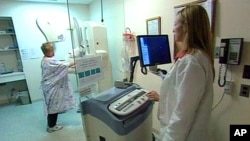A new genetic analysis of breast cancer has found four distinct types of the deadly disease, which experts say explains why drug therapy for one form of breast cancer may not work to cure another form. The findings are the latest fruits of a massive cancer-gene mapping project offering hope of more effective treatments for breast cancer, with already-available drugs.
Perhaps the most intriguing discovery yet by the U.S. government-funded Cancer Genome Atlas is that some breast cancer tumors are similar, genetically, to cancer cells that invade other parts of the body, so existing therapies might be repurposed to successfully treat cancers of the breast.
Scientists studying the DNA in breast cancer tumors from more than 800 patients found that cells in one of the breast cancer types resemble the basal-type cells found in ovarian cancer tumors. It’s possible, the researchers say, that the tumor might respond well to cisplatin-based drugs typically used for the gynecological cancer. Newer ovarian cancer drugs might also be beneficial against the breast tumors.
Jeff Boyd is senior vice president for Molecular Medicine at Temple University's Foxchase Cancer Center in Philadelphia, Pennsylvania. Gone are the days of one-size-fits-all treatment for breast cancer, says Boyd.
“What we are learning is that we’ve got to get beyond treat[ing] every breast cancer the same. Do a lumpectomy, treat with these three drugs, irradiate locally and cross your fingers," he explained. "We now know, as we are beginning to learn for many cancer types, that there are multiple molecular cancer genetics that essentially render them separate diseases.”
Two other cancer types identified in the genomic study, called luminal A and B, are triggered into mutating by a gene called HER2. A drug called Herceptin can block that gene, stem its growth and improve the prognosis for women with these types of cancer. Herceptin has been approved for use to treat all breast cancers, yet not every tumor responds to the drug, and now researchers have a better understanding why.
Mathew Ellis is a cancer researcher at Washington University in St. Louis, Missouri, who has collaborated on the Cancer Genome Atlas. Ellis hopes targeted therapies for the different types of breast cancer will soon become available to help his patients.
“Now we have to fast-forward to a day -- hopefully in the next year or two -- where at least in clinical studies the information is flowing forward to the patients and doctors. And critically that data flow includes access to the drugs,” Ellis stated.
The project funded by the U.S. National Cancer Institute began in 2006 with the goal of trying to identify the biomolecular underpinnings of more than 200 human cancers. The research involving breast cancer initially identified the genetic signatures of tumors that led researchers to conclude there was probably more than one breast-cancer type. The latest findings, published in the journal Nature, offer that proof.
Perhaps the most intriguing discovery yet by the U.S. government-funded Cancer Genome Atlas is that some breast cancer tumors are similar, genetically, to cancer cells that invade other parts of the body, so existing therapies might be repurposed to successfully treat cancers of the breast.
Scientists studying the DNA in breast cancer tumors from more than 800 patients found that cells in one of the breast cancer types resemble the basal-type cells found in ovarian cancer tumors. It’s possible, the researchers say, that the tumor might respond well to cisplatin-based drugs typically used for the gynecological cancer. Newer ovarian cancer drugs might also be beneficial against the breast tumors.
Jeff Boyd is senior vice president for Molecular Medicine at Temple University's Foxchase Cancer Center in Philadelphia, Pennsylvania. Gone are the days of one-size-fits-all treatment for breast cancer, says Boyd.
“What we are learning is that we’ve got to get beyond treat[ing] every breast cancer the same. Do a lumpectomy, treat with these three drugs, irradiate locally and cross your fingers," he explained. "We now know, as we are beginning to learn for many cancer types, that there are multiple molecular cancer genetics that essentially render them separate diseases.”
Two other cancer types identified in the genomic study, called luminal A and B, are triggered into mutating by a gene called HER2. A drug called Herceptin can block that gene, stem its growth and improve the prognosis for women with these types of cancer. Herceptin has been approved for use to treat all breast cancers, yet not every tumor responds to the drug, and now researchers have a better understanding why.
Mathew Ellis is a cancer researcher at Washington University in St. Louis, Missouri, who has collaborated on the Cancer Genome Atlas. Ellis hopes targeted therapies for the different types of breast cancer will soon become available to help his patients.
“Now we have to fast-forward to a day -- hopefully in the next year or two -- where at least in clinical studies the information is flowing forward to the patients and doctors. And critically that data flow includes access to the drugs,” Ellis stated.
The project funded by the U.S. National Cancer Institute began in 2006 with the goal of trying to identify the biomolecular underpinnings of more than 200 human cancers. The research involving breast cancer initially identified the genetic signatures of tumors that led researchers to conclude there was probably more than one breast-cancer type. The latest findings, published in the journal Nature, offer that proof.
